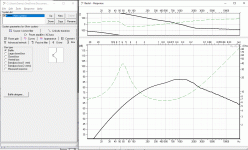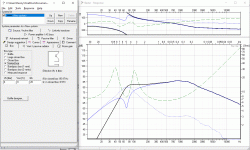I was hoping to get some input on my first build, which I fear might be too weird to pull off. It's a desktop 2 way open baffle using a ribbon + woofer and DSP crossovers. I've never made a speaker before but have done a share of complicated DIY projects (drones and go-karts). After being blown away by a pair of spatials I thought I'd finally try my hand at a OB speaker, since according to the great Linkwitz, an OB is very hard to screw up.
For a tweeter with dipole behavior I picked up 2 dayton mid/tweeter ribbons that go from 250 to 20,000hz and a 4" aluminum woofer picked for flat FR, low group delay, and relatively high excursion for DSP purposes
Since I'd heard low crossovers are desirable the plan was to get the ribbons to cover down to ~500hz (or lower if possible). But since I heard crossovers can be the achilles heel for a speaker I opted for a minidsp which would split signals prior to 4-in-4-out 100W per channel class D amp so I could experiment with different crossover points and filter types. I was aiming to make the baffle as small as possible—which I know is detrimental to bass, but with a desktop system with a 4' woofer I'm not trying to dig into the sub-bass regions much at all. I just want some presence in the 100hz range.
With the sensitivities being different I wanted to know whether being able to independently control the gain to each driver through a miniDSP would compensate. My worry is that, should the spl-to-wattage response of the drivers be nonlinear, that there'd only be one gain sweetspot where the drivers would blend. Second, I was hoping to get some input on doing tiny open baffles. Why aren't they done more often? Given that small speakers aren't expected to have bass and that low bass is a common complaint for OB's, I'd figure mini OB projects would be more popular? Do the advantages of OB (less placement sensitivity, more open sound) not translate to small systems?
Finally, any recommendations or warnings? Thanks in advance!
For a tweeter with dipole behavior I picked up 2 dayton mid/tweeter ribbons that go from 250 to 20,000hz and a 4" aluminum woofer picked for flat FR, low group delay, and relatively high excursion for DSP purposes
Since I'd heard low crossovers are desirable the plan was to get the ribbons to cover down to ~500hz (or lower if possible). But since I heard crossovers can be the achilles heel for a speaker I opted for a minidsp which would split signals prior to 4-in-4-out 100W per channel class D amp so I could experiment with different crossover points and filter types. I was aiming to make the baffle as small as possible—which I know is detrimental to bass, but with a desktop system with a 4' woofer I'm not trying to dig into the sub-bass regions much at all. I just want some presence in the 100hz range.
With the sensitivities being different I wanted to know whether being able to independently control the gain to each driver through a miniDSP would compensate. My worry is that, should the spl-to-wattage response of the drivers be nonlinear, that there'd only be one gain sweetspot where the drivers would blend. Second, I was hoping to get some input on doing tiny open baffles. Why aren't they done more often? Given that small speakers aren't expected to have bass and that low bass is a common complaint for OB's, I'd figure mini OB projects would be more popular? Do the advantages of OB (less placement sensitivity, more open sound) not translate to small systems?
Finally, any recommendations or warnings? Thanks in advance!
Last edited:
I just read this one
Open Baffle Speakers by Irkiosan
I put the last page where you can see the final setup- The man seems to have understood the basics of OB
Open Baffle Speakers by Irkiosan
I put the last page where you can see the final setup- The man seems to have understood the basics of OB
You should put your crossovers before the amps.
Yes that's the plan—the miniDSP divides the signal which then feeds into a 4in/4out class D amp which goes to the drivers. am I understanding correctly?
Yes, you are understanding perfectly.
Use a tweeter protection capacitor - this protects tweeter against damage due to accidental exposure to bass and turn-on pops.
Try it and report back.
Make a rough mock-up first to prove the principle.
Use a tweeter protection capacitor - this protects tweeter against damage due to accidental exposure to bass and turn-on pops.
Try it and report back.
Make a rough mock-up first to prove the principle.
It's a bad idea to use a 4" in OB as woofer.
I would go for semi OB: 4" in 4l vented, planar as OB
A small 4" in OB with a minimal baffle will not reach 100Hz.
Here's an OB sim in Basta! you see it's already down 15db at 100Hz
I also did a sim with a 4 liter box that will give you below 100Hz output
I would go for semi OB: 4" in 4l vented, planar as OB
A small 4" in OB with a minimal baffle will not reach 100Hz.
Here's an OB sim in Basta! you see it's already down 15db at 100Hz
I also did a sim with a 4 liter box that will give you below 100Hz output
Attachments
Danny thank you for the advice—very useful simulation you sent me. I will get enough wood to try an H frame and ported options as well.
Yes, you are understanding perfectly.
Use a tweeter protection capacitor - this protects tweeter against damage due to accidental exposure to bass and turn-on pops.
Try it and report back.
Make a rough mock-up first to prove the principle.
Tweeter protection cap—got it! Thank you. Will definitely report back
It probably is and one should use a (much) bigger woofer but:It's a bad idea to use a 4" in OB as woofer.
- I´ve seen designs around here and people seemed happy with it.
(found one example:
S11 OB - Revisiting Desktop OB design using Seas 8" and Tang Band Full-Range)
- If we accept the fact that such a system is very much limited in SPL and also bass extension, one could EQ the bass response and compensate for at least some dipole loss.
After all, when nearfield you only need so much SPL.
A potent 6.5" or 8" driver (assuming there is some space on the desk) EQed just right, meaning extending bass response to the max but probably applying some kind of highpass too to limit excursion could actually come out OK.
I have been using little fullrange speakers (3" Tangband) on my desktop for a while and these were a much bigger compromise in comparison to the envisioned 2-way-OB above.
Last edited:
Talking about the speakers in post 3 using the Visaton WS25E woofer,
the smaller brother WS17E would be a nice candidate for a desktop-OB, if space permits maybe even the 10"!
the smaller brother WS17E would be a nice candidate for a desktop-OB, if space permits maybe even the 10"!
A H-frame is typically used for sub-/woofer-duties.I will get enough wood to try an H frame and ported options as well.
It has a resonance above which a h-frame usually isn´t used which in turn would mean to cross the tweeter really low=too low.
Also the dispersion will suffer and is one of many reasons you never see a h-frame crossed over to the tweeter at 1-2k or similar.
I´d go with a plain baffle.
You can always experiment with cardboard wings and/or add solid wings later to create a U-baffle.
That S11 OB is an 8", it has 4x more Sd area than this Dayton 4"
Eq the bass of the 4" in OB with 15-20db is not possible, you'll hit the limits of the driver and your amplifier
Eq the bass of the 4" in OB with 15-20db is not possible, you'll hit the limits of the driver and your amplifier
- Home
- Design & Build
- Construction Tips
- tiny open baffle, ribbon+woofer w/ low digi crossover. bad idea?

